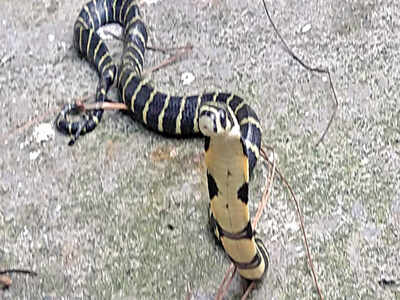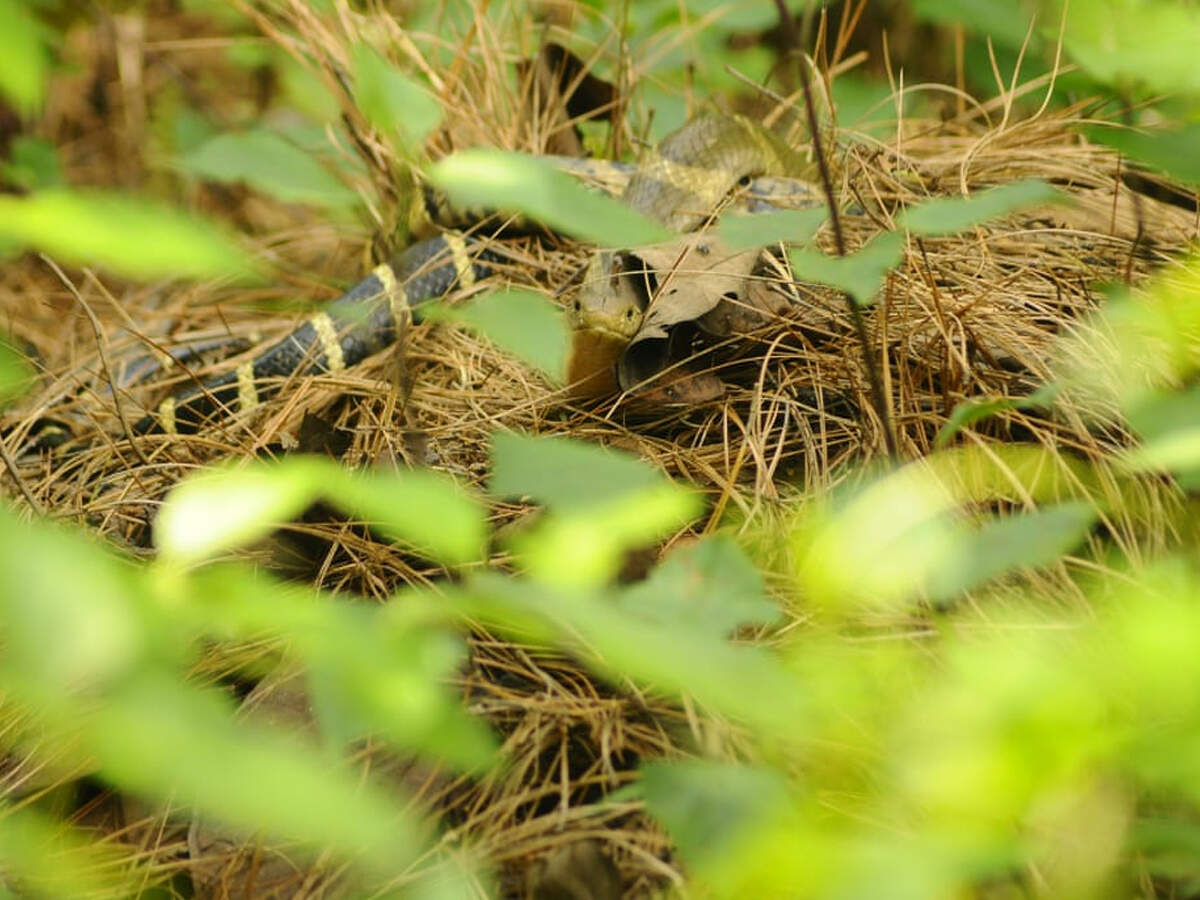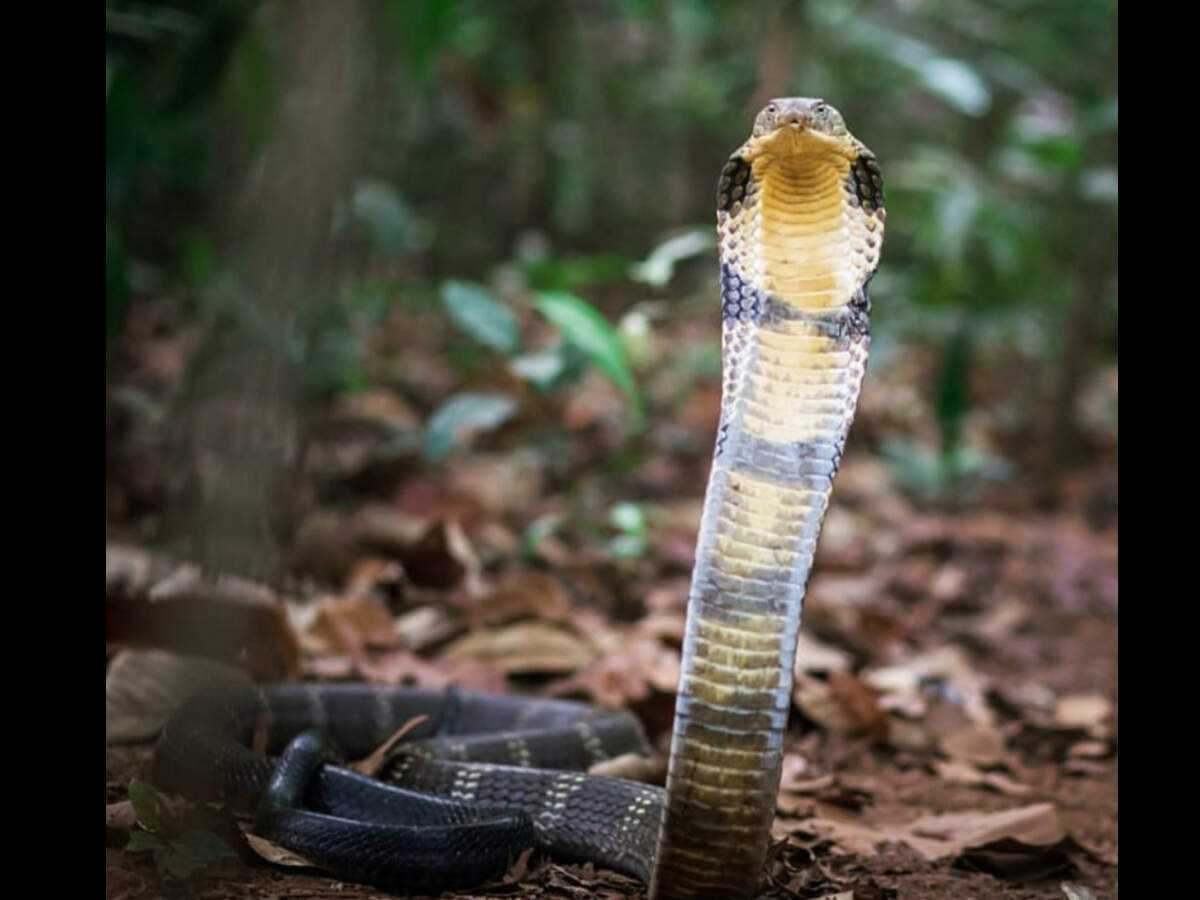
NAINITAL: Forest officials in Uttarakhand have for the first time recorded sightings of king cobra (Ophiophagus hannah) at heights of 2,200 m to 2,400 m in the Himalayas, a new altitude record for the species which has led to several experts calling for a detailed study on the how the world’s largest venomous snake was thriving at such elevations.
The observations, part of a report prepared by the Uttarakhand forest department’s research wing in Haldwani, a copy of which is with TOI, put the species’ habitat range as varying from 400 m in Terai region to up to 2,400 m in the hills. The report said that such a wide variation in habitat for a cold-blooded or ectothermic species was “unusual” and demands scientific investigation.

Reptiles are cold-blooded, meaning they depend on external heat sources for thermoregulation and generally prefer warmer climates. But during a nine-month study, forest officials found nests of the snake — classified as ‘vulnerable’ in the International Union for Conservation of Nature (IUCN) list — at heights of up to 2,400 m in Mukteshwar (Nainital district) where winter temperatures are close to freezing and snowfall is common.

Chief conservator of forests (research) Sanjeev Chaturvedi said that the research involved field investigations as well as interviews with local residents. “We found several king cobra nests in higher altitudes in Mukteshwar, even at 2,400 m. This is the highest altitude at which a king cobra has ever been sighted,” Chaturvedi told TOI.
A study published in the journal Herpetology Notes in 2018 authored by Jignasu Dolia, a researcher at the Dehradun-based Wildlife Institute of India, had mentioned the highest recorded altitude for the king cobra — India’s national reptile — at 2,303 m after a hatchling was found in the Indian Veterinary Research Institute’s (IVRI) campus in Mukteshwar in 2012. The species has been sighted at 1,840 m in Sikkim, 1,170 m in Mizoram and 1,830 m in the Nilgiris.
In the upper reaches of Nainital where the king cobra was spotted, it was using pine needles — inflammable leaves of pine trees that enable forest fires to spread every year — to build nests, said the forest department’s report. “The species is traditionally found in rainforests of Western Ghats, Eastern Ghats, the Northeast and mangroves of Sunderbans and Odisha. On the basis of available data, it may be safely inferred that Nainital, perhaps, has the most robust recorded population of king cobra outside of its traditional habitats,” it added.
Experts said that detailed investigations were needed to understand how the species seemed to be adapting to colder climates further up in the Himalayas. According to WII herpetologist Abhijit Das, “Cobras are very adaptive and could have found it easy to take to a new environment.”
The scientist said that global warming may have played a role as well, turning cooler areas warmer and more adaptable, but added that this would need extensive studies to prove.
Another reason could be that the species was simply “following the food chain”.
“As more people settle in upper reaches in places like Nainital, they end up creating more garbage which attracts rats which are preyed upon by snakes,” he said.
It could also be that we have only now started to document the distribution of King Cobra, added S Satyakumar, senior professor at WII. Scientists at the Zoological Survey of India also backed the thought.
“It’s possible that we have more sightings now because forest departments are better equipped to conduct such research work. The species is very elusive and might even exist in elevations higher than what we have currently recorded. More research could help us understand this,” said Pratyush Mohapatra, senior scientist, Zoological Survey of India, Madhya Pradesh.
(With inputs from Shivani Azad)
The observations, part of a report prepared by the Uttarakhand forest department’s research wing in Haldwani, a copy of which is with TOI, put the species’ habitat range as varying from 400 m in Terai region to up to 2,400 m in the hills. The report said that such a wide variation in habitat for a cold-blooded or ectothermic species was “unusual” and demands scientific investigation.

Reptiles are cold-blooded, meaning they depend on external heat sources for thermoregulation and generally prefer warmer climates. But during a nine-month study, forest officials found nests of the snake — classified as ‘vulnerable’ in the International Union for Conservation of Nature (IUCN) list — at heights of up to 2,400 m in Mukteshwar (Nainital district) where winter temperatures are close to freezing and snowfall is common.

Chief conservator of forests (research) Sanjeev Chaturvedi said that the research involved field investigations as well as interviews with local residents. “We found several king cobra nests in higher altitudes in Mukteshwar, even at 2,400 m. This is the highest altitude at which a king cobra has ever been sighted,” Chaturvedi told TOI.
A study published in the journal Herpetology Notes in 2018 authored by Jignasu Dolia, a researcher at the Dehradun-based Wildlife Institute of India, had mentioned the highest recorded altitude for the king cobra — India’s national reptile — at 2,303 m after a hatchling was found in the Indian Veterinary Research Institute’s (IVRI) campus in Mukteshwar in 2012. The species has been sighted at 1,840 m in Sikkim, 1,170 m in Mizoram and 1,830 m in the Nilgiris.
In the upper reaches of Nainital where the king cobra was spotted, it was using pine needles — inflammable leaves of pine trees that enable forest fires to spread every year — to build nests, said the forest department’s report. “The species is traditionally found in rainforests of Western Ghats, Eastern Ghats, the Northeast and mangroves of Sunderbans and Odisha. On the basis of available data, it may be safely inferred that Nainital, perhaps, has the most robust recorded population of king cobra outside of its traditional habitats,” it added.
Experts said that detailed investigations were needed to understand how the species seemed to be adapting to colder climates further up in the Himalayas. According to WII herpetologist Abhijit Das, “Cobras are very adaptive and could have found it easy to take to a new environment.”
The scientist said that global warming may have played a role as well, turning cooler areas warmer and more adaptable, but added that this would need extensive studies to prove.
Another reason could be that the species was simply “following the food chain”.
“As more people settle in upper reaches in places like Nainital, they end up creating more garbage which attracts rats which are preyed upon by snakes,” he said.
It could also be that we have only now started to document the distribution of King Cobra, added S Satyakumar, senior professor at WII. Scientists at the Zoological Survey of India also backed the thought.
“It’s possible that we have more sightings now because forest departments are better equipped to conduct such research work. The species is very elusive and might even exist in elevations higher than what we have currently recorded. More research could help us understand this,” said Pratyush Mohapatra, senior scientist, Zoological Survey of India, Madhya Pradesh.
(With inputs from Shivani Azad)
Quick Links
Kerala Coronavirus Helpline NumberHaryana Coronavirus Helpline NumberUP Coronavirus Helpline NumberBareilly NewsBhopal NewsCoronavirus in DelhiCoronavirus in HyderabadCoronavirus in IndiaCoronavirus symptomsCoronavirusRajasthan Coronavirus Helpline NumberAditya ThackerayShiv SenaFire in MumbaiAP Coronavirus Helpline NumberArvind KejriwalJammu Kashmir Coronavirus Helpline NumberSrinagar encounter
Get the app








